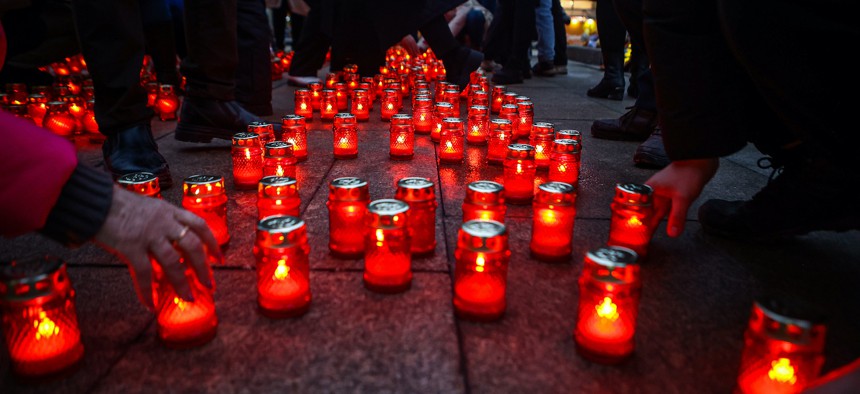
People lay carnations and light up candles near the chapel of St. Nicholas the Wonderworker to commemorate the people who were killed during the terrorist attack at Moscow concert hall, on March 25, 2024 Rostislav Netisov / Anadolu via Getty Images
The Islamic State’s Afghanistan-based affiliate is emerging as a global menace
ISIS-K’s bombing in Moscow shows the group's increasingly deadly reach.
News of the recent horrific attack in Moscow by the Islamic State in Iraq and Syria—Khorasan Province (also known as ISIS-K) is putting a spotlight on a group that was already notorious for its brutal methods in Afghanistan and the broader Middle East. The operation in Moscow arrived a few weeks after U.S. officials warned that credible intelligence suggested an attack was brewing in Russia. Still, it appears to be a dramatic escalation of the group’s ability to launch complex attacks well outside its home base in Afghanistan.
Late last year, people linked to ISIS-K were arrested and charged with planning to to bomb a cathedral in Cologne, Germany. In January, ISIS-K claimed responsibility for a large attack in Kerman, Iran, carried out by two suicide bombers at the funeral procession for former Islamic Revolutionary Guard Corps Quds Force Commander Qassem Soleimani. (As with the Moscow attack, U.S. officials reportedly had attempted to give warning to Tehran.) A few days ago, German authorities also announced that two other people with ISIS-K ties and of Afghan descent were arrested as they plotted to attack the Swedish parliament in response to Quran burnings in Sweden last year.
These developments suggest ISIS-K is able to recruit, train, and deploy operatives outside Afghanistan for plots hundreds if not thousands of miles away. The Moscow attack in particular seems troubling. It required fairly complex preparation, including travel without being denied entry and organization without being detected by Russian intelligence or law enforcement. And it involved four people who mimicked active-shooter tactics used against mass gatherings in Mumbai in November 2008 (carried out by the Pakistan-based terrorist group Lashkar e-Tayyiba using trainees from Pakistan) and Paris in November 2015 (carried about by ISIS in Iraq and Syria using ISIS sympathizers in Belgium and France).
Against this complex backdrop of ISIS attacks and disrupted plots, U.S. warnings about different threats, and the realities on the ground in Afghanistan following the U.S. and Western military withdrawal and return of the Taliban government as the ruling power there, what does this all mean? How can the international community work to prevent additional attacks from a group that now looks far more dangerous than even just a few years before? In order to answer these and related questions, we need to look at the origins of ISIS-K going back nearly a decade.
As ISIS emerged as a major threat in the Middle East in the mid-2010s, it was striking to watch other jihadist organizations come to life or rebrand themselves with the ISIS moniker. Before the loss of the ISIS self-declared caliphate in Iraq and Syria in 2017 and 2018, perhaps dozens of jihadist groups had pledged their allegiance to ISIS. They included ISIS-K, which by 2014 and 2015 included disaffected fighters from the Pakistan-based Tehrik-e-Taliban, a violent jihadist group that had fought against the Pakistani government and even sponsored a plot by American citizen Faisal Shahzad in May 2010 to detonate a car bomb in Times Square—and other Central Asian-based jihadists and members of the Afghan Taliban as well.
Using Afghanistan’s Nangarhar Province as its stronghold, the group waged a number of attacks inside the country against a range of targets and ethnic and religious minorities. But by the late 2010s, military pressure from the U.S.-led coalition and the Taliban had pushed the group from Nangarhar and forced it to operate at smaller levels across different parts of the country. This appeared to be a serious setback—and yet the group was able to withstand this territorial loss and reemerge in a stronger position heading into the next decade.
Just how much stronger became apparent on Aug. 26, 2021, when ISIS K’s deadly attack at Kabul airport during the U.S. withdrawal killed 170 Afghans and 13 U.S. military personnel. Exploiting the chaos and the Taliban’s own rapid advances, the group had managed to get a suicide bomber past several security checkpoints before detonating his device. The United States and the Taliban subsequently worked to take action against ISIS-K, killing or capturing members associated with the plot within days and nearly two years later.
ISIS-K appears to have only grown more brazen since 2021. This may reflect the sparse Western military presence that remains in Taliban Afghanistan. It may also reflect the Taliban’s own limited ability to control the country. Finally, it may reflect Taliban sympathy for ISIS-K, whose members include many former Taliban.
Regardless, on the heels of the Moscow attack and against the backdrop of other ISIS-K plots, now is not the time for complacency. And while other national security priorities issues and conflicts around the world are drawing U.S. attention and resources, refocusing efforts on ISIS-K—even without the significant military presence in Afghanistan that endured for two decades—can help mitigate future threats from this dangerous group.
Javed Ali is an Associate Professor of Practice at the University of Michigan’s Gerald R. Ford School of Public Policy. He had over 20 years professional experience in Washington, DC on national security issues, to include senior roles at the Federal Bureau of Investigation, Office of the Director of National Intelligence, and National Security Council focused on counterterrorism.
NEXT STORY: How to keep China out of the Pentagon’s weapons


